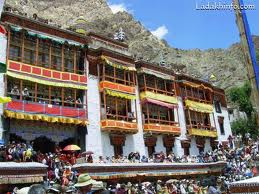Ladakh is located at the western side of Himalayas and is protected by four mountains ranges namely Himalayan, Zanskar, Ladakh and Karakoram. The place is surrounded by a labyrinth of extremely elevated flurry capped peaks and the principal glaciers exterior to the glacial area, rule the topography where gorge depth array from a mere 8000 ft. to 15000 ft. while passes of up to 20000 ft. and peaks getting above 25000 ft. be able to be seen all about. The world's biggest glacier external to the glacial county, Siechen is at this time. Such intimidating stature, establish the land's temperature.
The main watercourse of Ladakh is Indus which penetrates India from Tibet at Ldemchok. Opening in
close proximity to Mt. Kailash, the Indus according to Mythology, develops commencing the mouth of a loin, and is consequently branded as Senge Khababs. Hence the summer time you will hardly find it getting any warmer than 27 degrees. But during winters even Leh is as cold as -20 degrees Celsius.At this height, the air is so thin, the heat of the sun is more intensely felt here than at lower altitudes. That is why it is said Ladakh is the only place on earth where you can get sunburn as well as frostbite at the same time. Ladakh is surrounded by worlds biggest mountain ranges ; the Himalayan range and the Karakoram. These lay crossways two others Zanskar and Ladakh range. The highest altitude you will find here is from 2750 to 7637 m.
For first timers Ladakh leaves them spell bound. There is such a vast cultural difference between Ladakh and other regions people are taken in by that. Ladakh has an amazing history too. The land of lost Shangri la is mysterious enough and its several monasteries and local stories intrigue the listener even more.
The culture of Ladakh is pretty influenced by the Tibetans. Buddhism is the main religion followed here. The first population to be here was Mons from Tibet and Kullu. Drads came later and started to live in lower Ladakh.
Ladakh is known as little Tibet due to its Tibetan influence. Kargil district on the other hand is dominated by Muslims. As you trek to Ladakh you will find several walls that are studded with engraved stones that bear the mantra "Om Mani Padme Hum". There are chortens which exhibit Budhha teachings. There are villages which are decorated with gompa and monasteries that have hermits, monks residing since such a long time. Kashmir bought Islam to Ladakh around the 15th century. Places like Drass, Suru valley have Shias ans Sunnis living there.
The best time to come to Ladakh is during the summers. Winters if you plan to come you better make all your arrangements in advance.










No comments:
Post a Comment